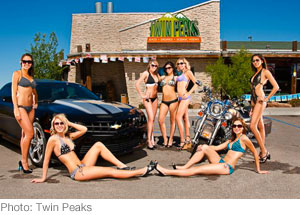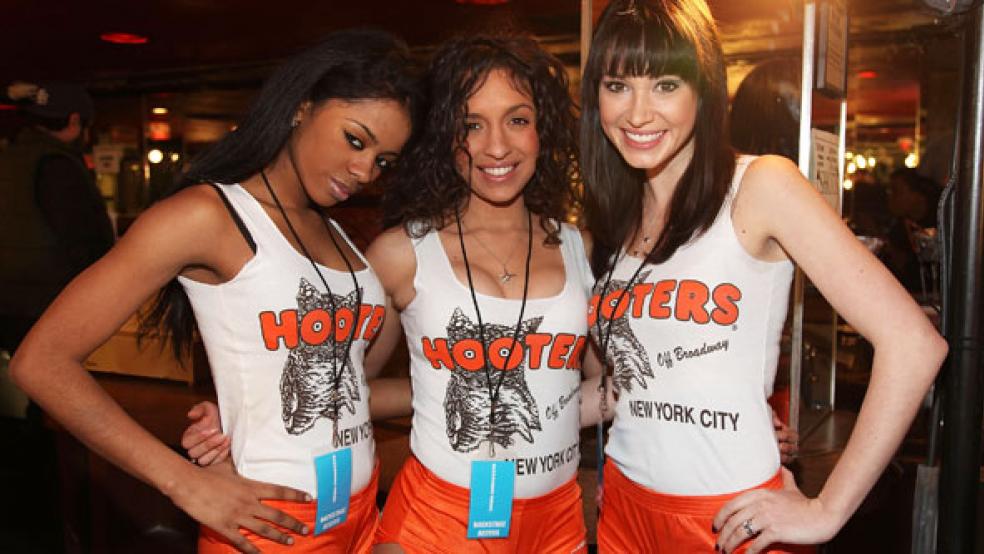It's been about 15 years since I was last in Hooters on a family vacation that took a strange turn one hungry, lost afternoon, but little seems to have changed. “It definitely needs an overhaul,” Darren Tristano, an Executive Vice President at Technomic, a food industry consulting firm, says of the brand. “It’s considerably outdated.” The only clear indicator of the 21st century at the Hooters in Midtown Manhattan is a sticker on the front door offering free wifi.
Related: The 13 Most Expensive Bikini's in the World
Faced with increased competition in the crudely termed “breastaurant” business, tough economic times, and the increasingly sophisticated tastes of consumers, Hooters is struggling. Sales in the U.S. fell by 7.5 percent, from 960 million to 888 million, from 2007 to 2010, and more than a dozen domestic locations shuttered, according to Technomic data. By comparison, the varied-menu chain restaurant segment as a whole saw sales fall by 8.6 percent over the same period. “It’s pretty common knowledge that the casual dining space has been challenged,” says Hooters CEO Terry Marks. “The sales decline that Hooters experienced was not as deep, but we went into decline a bit earlier and have been slower to pull out of it.”

Hooters Performs a Self-Examination
In an effort to revive the brand, last December the company embarked upon what Marks calls the “most comprehensive body of work in trying to understand how users and lapsed users feel about the brand.". Over the last few months, customers and potential customers have been extensively surveyed both online and in-store to help determine where Hooters should go next. “It’s all about aiming well before you fire,” says Marks.
One key finding to come out of the research he says is that “it’s all about the food.” Marks talks of plans to expand the menu beyond its famous wings and basics to include more gourmet offerings, like burgers with high-quality beef and a shrimp and spinach salad that’s on the menu at the “new generation” Hooters that opened last month in downtown Atlanta -- a “semi-prototype” of Hooters to come. Over the next three or four years, Marks say there are plans to remodel a “significant majority” of the nearly 400 Hooters locations across the country. There are no plans to open any additional corporate stores in 2012.
Meanwhile, relative newcomers in the "breastaurant " business are rapidly expanding and nipping at Hooters’ panty-hose clad heels. Since it was founded in Denver in 2005, Twin Peaks, which touts its “scenic views,” has rapidly grown to 20 locations in eight states and plans to open at least 30 outlets at the end of year, staffed by comely women in hiking shorts and plaid crop-tops. Twin Peaks draws easy comparisons to Hooters not just in concept but also in its talent pool. Last May, the chain hired Rick Akam, who served as Hooters’ President and CEO from 1995 to 2003, to serve as its Chief Operating Officer.
Hooters Execs Strike Back at Siliclones
Then, in August, just a month after leaving his post as president and CEO of Hooters, Coby Brooks, whose father Robert H. Brooks had a majority stake in Hooters and was integral to its success until his death in 2006, led an investment group to ink a deal to open 35 Twin Peaks locations over the next decade. Some half a dozen other former top Hooters execs are now part of La Cima Restaurants group, along with Brooks. In September, Hooters brought a lawsuit against La Cima alleging that one of its execs had stolen trade secrets. It has yet to be settled, and Hooters declined to comment on the matter.
Twin Peaks president Jack Gibbons is more vocal when asked about it, calling it “interesting” and the “best kind of flattery” that Brooks would join his team. He professes amusement at the idea of “trade secrets” in the breastaurant biz, though he admits to the obvious similarities. “The idea of Twin Peaks is to take an outdated idea and make it fresh and innovative,” he says. He notes the quality of the food, which he says is aided by the fact that Twin Peaks is part of the Texas-based Front Burner Restaurants group, which runs a variety of restaurants with relatively modern menu offerings. “Have you eaten in a Hooters lately?” he asks with a laugh.
Meggie Miller, Twins Peaks’ Director of Marketing raves about Twin Peak’s “comfortable and very flattering” uniforms and touts internal programs stressing health and fitness and opportunities for Twin Peaks girls to move up the company ladder. “The girls, they take care of themselves,” says Gibbons.
Staying Abreast of Changes in Customer Tastes
Twin Peaks isn’t the only rapidly developing breastaurant. Tilted Kilt, an Arizona based franchise with a Celtic theme — think knee-high socks, short plaid kilts, exposed plaid bras — has grown in recent years, from eight restaurants in 2007 to 46 in 2010. Brick House Tavern + Tap, a “man cave” themed concept restaurant from the same company that brought Joe’s Crab Shack to a mall near you, has also seen rapid growth, expanding to 16 locations since launching in 2008. But, despite such rapid growth in the sector, Technomic’s Tristano says the good times won’t last forever and that the market will become over-saturated soon enough. “Three years from now, we’ll start to see some of the fallout,” he says. That's when the industry will need more support to lift it out of the doldrums.

